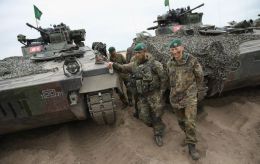Russia's summer plan: Key frontline areas for future offensive
 Russia is trying to attack in 10 directions, the Ukrainian Defense Forces managed to stop the Russians in some places (photo: GettyImages)
Russia is trying to attack in 10 directions, the Ukrainian Defense Forces managed to stop the Russians in some places (photo: GettyImages)
Russia is conducting offensive operations on ten fronts. On some of them, it will want to achieve operational success. What's going on and where the most fierce summer battles may occur - read in the RBC-Ukraine article.
Contents
Russia has been continuing its offensive campaign along the entire front for nine months. At the end of last year, most observers, analysts, and Western officials predicted that Ukraine would spend 2024 on strategic defense. However, a six-month delay in disbursement of US aid has complicated even this task.
It was expected that the inflow of new weapons and ammunition from American partners would allow Ukraine to stop Russia's advance within two months and stabilize the frontline to some extent. So far, this has not fully happened. The Ukrainian Defense Forces are still making efforts to at least slow down Russia's advance.
Russia is currently conducting offensive operations on ten frontlines at once. And Moscow will likely try to focus its efforts on four of them this summer. RBC-Ukraine's informed interlocutors in the Ukrainian Defense Forces say that it will most likely be the Pokrovsk direction, Kharkiv region, and Chasiv Yar.
Areas Russia is betting on: Donetsk region
The heaviest fighting is now taking place in the Pokrovsk direction, where the Russian occupiers are trying to push through in several areas at once. Previously, this was the Avdiivka direction, but after capturing this city, the Russians were able to advance almost 20 kilometers along the railroad since February. Russia quickly reached Ocheretyne and captured more than a dozen villages to the north and south.
Russia was able to gain tactical success in this area and will likely want to develop it into an operational success during the summer campaign. The Russian grouping here numbers up to 70,000 personnel, plus a significant reserve that they are not moving to other areas. This, in turn, also indicates that Russia will concentrate its efforts on the Pokrovsk direction.
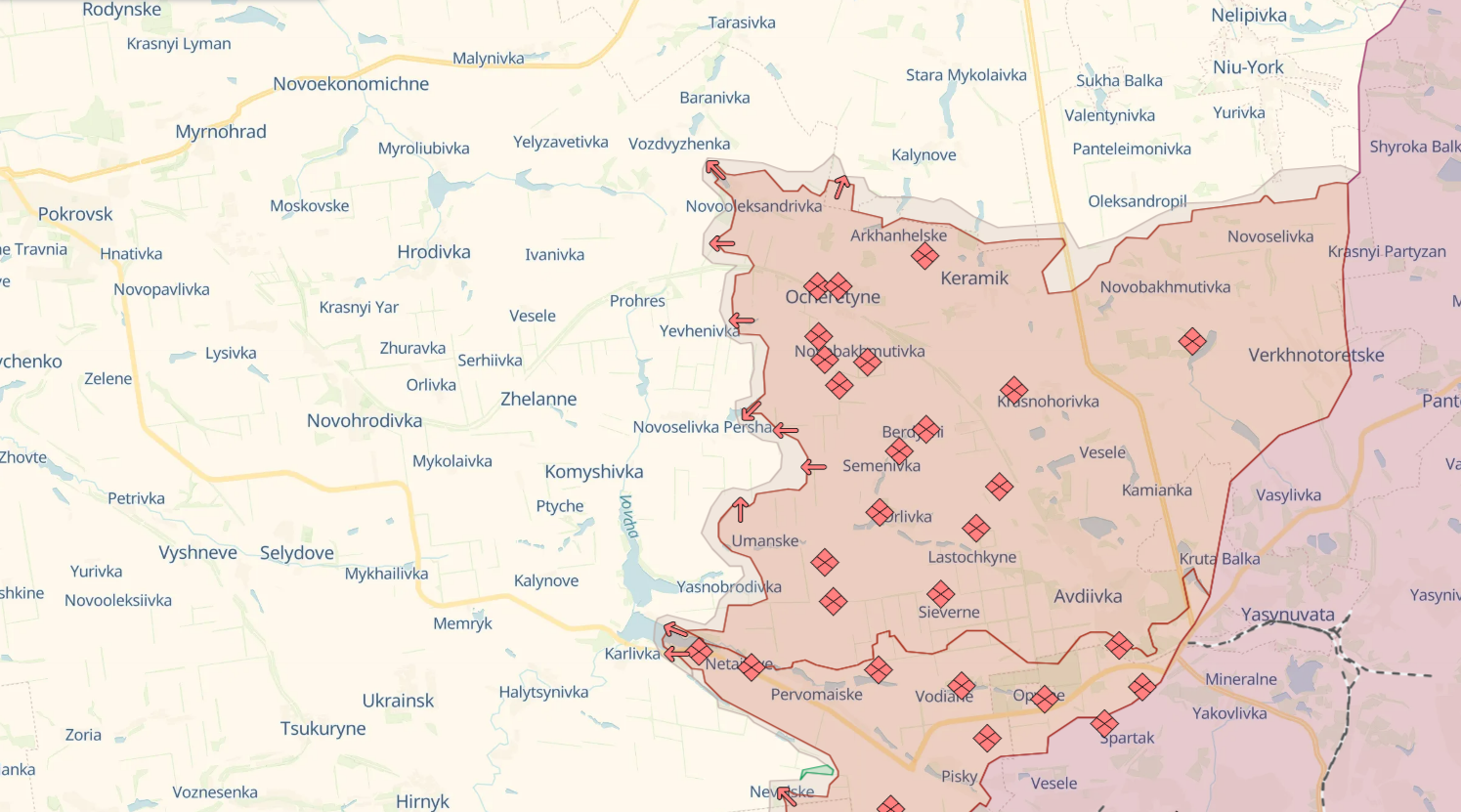 DeepState
DeepState
The Russians are now trying to expand the breakthrough area here towards two roads - one connecting Kostiantynivka and Pokrovsk, and the second one leading from Yasynuvata to Kostiantynivka. However, in recent weeks, the Russians have managed to slow down their movement here somewhat.
It seems that Russia's immediate task in this area is to reach the Vovcha River (the river of the same name flows near Vovchansk in Kharkiv region) in the area from Prohres to Yasnobrodivka. On the other hand, it is to advance to Vozdvyzhenka and then directly to the Kostiantynivka-Pokrovsk road in the area of Malynivka and Nova Poltavka.
The larger task here is to reach the city of Pokrovsk. In the end, there may be another option, which largely depends on the actions of another Russian group operating to the north - in the Kramatorsk direction.
There, the Russians continued to try to reach the Siverskyi Donets-Donbas canal, which runs from north to south through Chasiv Yar. They have already managed to do so south of the city, in the area west of Ivanivske. However, according to recent reports, it has not yet been able to cross the canal.
In Chasiv Yar itself, Russia managed to capture almost the entire eastern Kanal microdistrict. From the north, Russia is trying to capture Kalynivka to reach another microdistrict, Zhovtnevyi. At the same time, the Russian occupiers are trying to attack Ukrainian troops to the south to create more favorable conditions for entering the Novyi microdistrict.
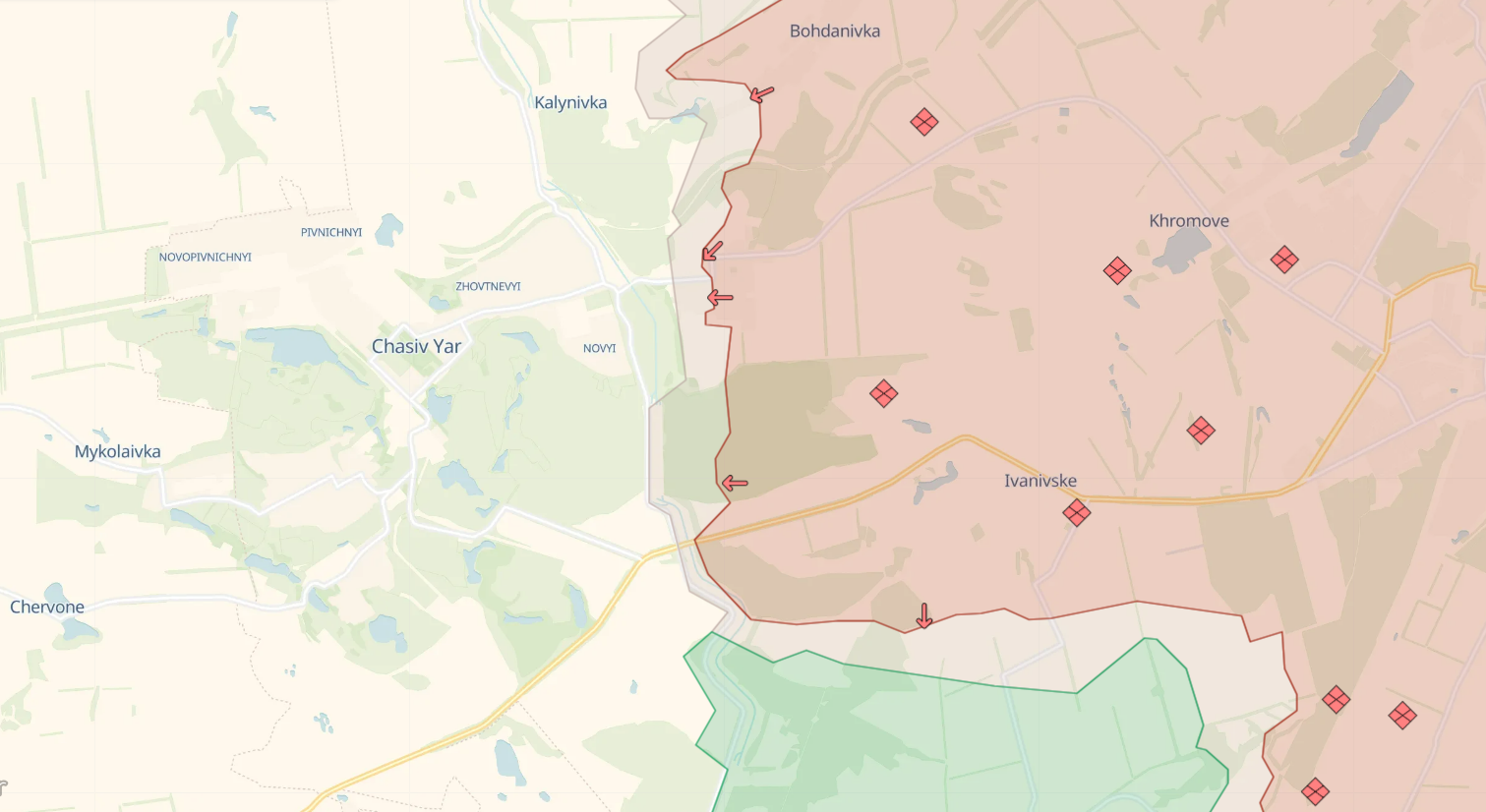 DeepState
DeepState
The attempt to capture this city will be another key task for the Russians this summer. After Chasiv Yar, Russia will be able to reach the Kramatorsk-Sloviansk agglomeration.
The simultaneous Russian advance in the Kramatorsk and Pokrovsk directions increases the threat to another area - the Toretsk direction. This is possible if the Russians manage, on the one hand, to push Ukrainian troops south of Chasiv Yar across the Siverskyi Donets-Donbas canal, and, on the other hand, to become more active north of Ocheretyne. The Toretsk area is currently the only location where the contact line has remained unchanged since 2014.
Russia's plans for this area are also indicated by its recent activation near Druzhba, Pivnichne, and Shumy. The latter village has already been occupied. According to OSINT observers, Russia caught Ukrainian troops on rotation and quickly took advantage of the situation. The capture of this area is another Russian goal soon. It is unlikely to be among its key tasks for the summer campaign, but in the event of further tactical successes here, the Russians may well shift their attention and forces to this area.
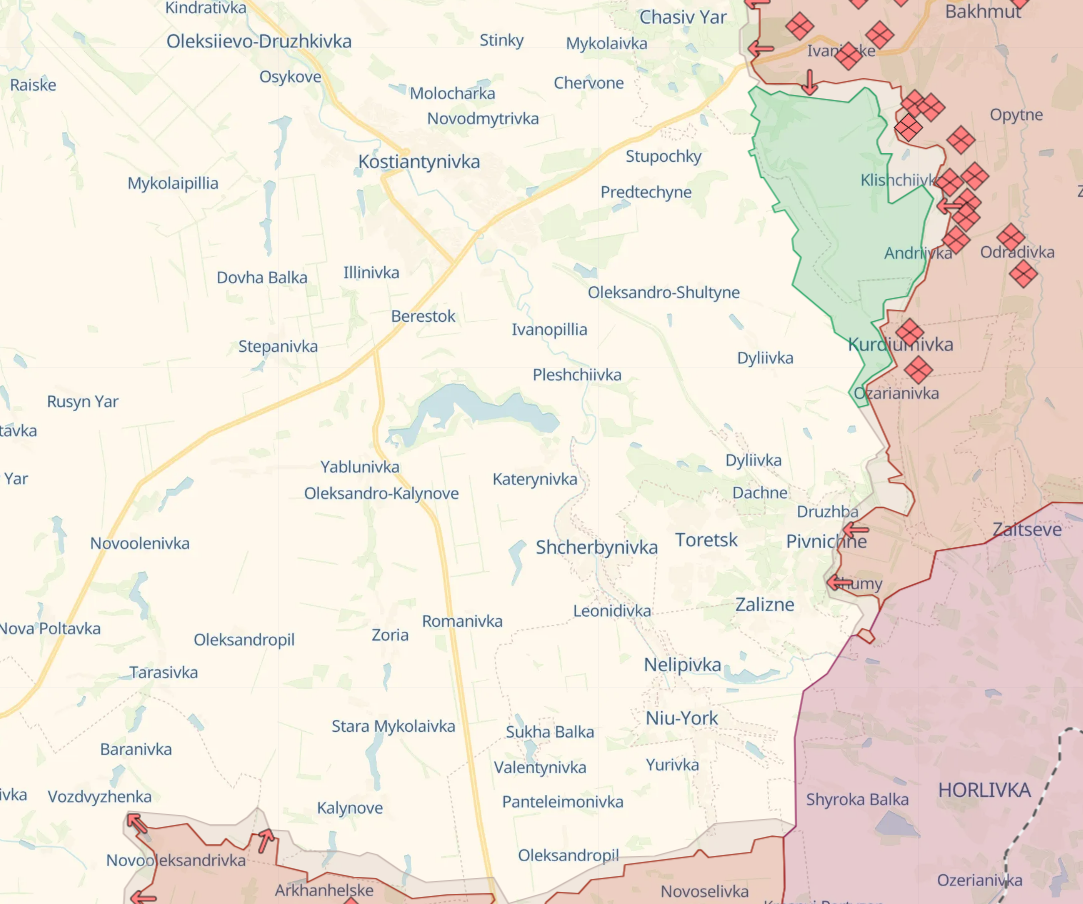 DeepState
DeepState
Another difficult section of the front is the Maryinka area or the Kurakhove direction. Here, the Russians are trying to move towards the villages of Kurakhove and Kostiantynivka (not the town of Kostiantynivka in the Kramatorsk direction) to form northern pincers for our grouping in Vuhledar. Here, Russia's advance has slowed down somewhat in recent weeks. And so far it does not seem that the Kurakhove-Vuhledar direction will be the one where the Russian occupiers will concentrate their main efforts during the summer. Russia's immediate task here is to gain access to the Kostiantynivka-Vodyane-Vuhledar road, which, in turn, will pose a threat to the supply lines of the Vuhledar group.
North and South
The Russian offensive in the north of Kharkiv region, which they launched on May 10, has slowed down. In one area, Russians are bogged down on the Hlyboke-Lukiantsi line. In another - in the area of Vovchansk. Not least because the West allowed them to fire their weapons into Russian territory.
Russia does not fully control Hlyboke, and according to available information, Lukiantsi is currently occupied. In Vovchansk, which seems to be a higher priority target for the Russians, it controls no more than a third of the city in the north. According to OSINT observers, a company of Russian occupants - up to 200 people - are trapped in a cauldron at the Aggregate Plant there. They are cut off from supplies and their main forces.
To increase pressure on Vovchansk, Russia is trying to approach the city from the west. To do this, they tried to force the Vovcha River near Hatyshche towards Synelnykove. At the same time, the Russians want to move westward across the bridge over the Siverskyi Donets to Prylipka, and then go to the Synelnykove area by road. Both of these options have not yet been realized.
In the north of the Kharkiv region, the Russians have already put their main reserve into action. Moreover, given that the Russian occupiers are sending troops from other directions, such as Kupiansk and Kramatorsk, to reinforce them, it is possible that pulling back Ukrainian troops and holding back the reserves is not the main goal of opening a new front in Kharkiv.
Another task may indeed be to create a so-called sanitary or buffer zone in our border area, as the Kremlin has previously discussed. But to do this, the Russians would have to advance into the depths of Ukrainian territory by about 30 kilometers. And they have not yet accomplished this task.
Interlocutors in the Ukrainian Defense Forces say that the Russians may resort to similar local actions in the Sumy region. The threat of assault actions and attempts to break through the border still exists. Russia is keeping a group of up to 15 thousand people near the Sumy region. However, the Russian command is still in a dilemma as to whether to get involved in this adventure, given the unplanned course of their offensive in the Kharkiv region.
Another possible scenario is that the Russian occupiers wanted to move southeast through Vovchansk to the area of Velykyi Burluk and get behind the Ukrainian group defending Kupiansk. Now the Russian troops are trying to approach this city from the opposite bank of the Oskil River. It looks like it was the passage to Kupiansk from the west, not the march on Kharkiv, that was the primary goal of the Russians' opening of the new front.
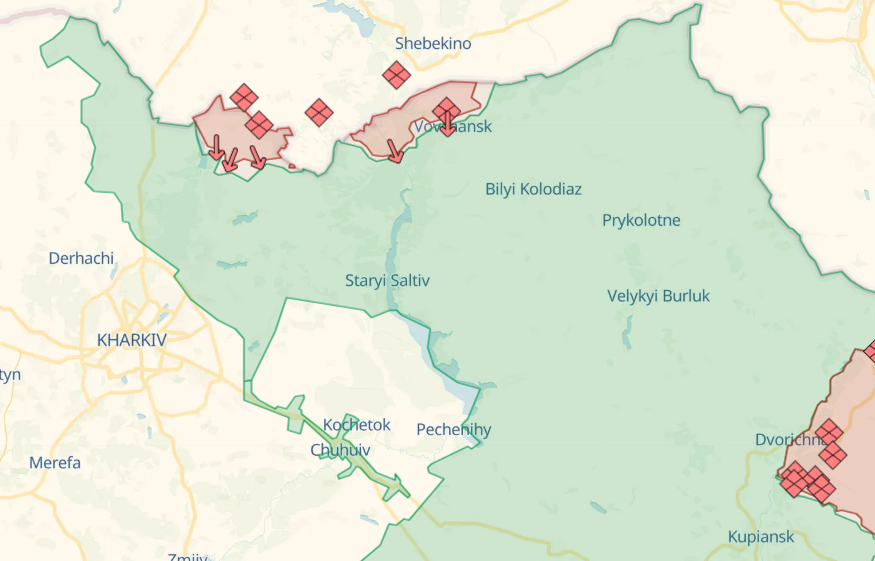
DeepState
In the Kupiansk direction, the Russian occupiers are trying to advance from east to west to the Oskil River. To do this, the Russians are alternately attacking and storming Ukrainian positions from different localities, from Lyman Pershyi to Novovodiane. Recently, DeepState analysts reported that, according to their data, Russia has assembled a 10,000-strong group in the area from Raihorodka to Novovodiane to move towards Borova, which is also located near Oskil, south of Kupiansk. In general, Russia's activity in all directions in the Kharkiv region indicates that this section of the front will be their focus at least during the summer campaign.
Further south in the Lyman direction, the Russians are still trying to push Ukrainian troops beyond the Chornyi Zherebets River between Makiivka and Torske without much success.
At the same time, the Russian occupiers have become more active in the South, trying to recapture the territories they lost in the summer of 2023. We are talking about the Orikhiv and Velyka Novosilka directions. On the first one, Russia has advanced to or, according to unconfirmed reports, has already reached Robotyne. On the second, Russia has entered or has already occupied Staromayorske continues fighting for Urozhaine, and is trying to advance from Pryiutne.
Despite their pace, the Russians do not have enough strength to advance in a dozen directions at once. But at least in four or five of them, the Russian occupiers will try to achieve operational success during the summer. The Pokrovsk direction looks the most threatening in this regard.
Currently, the Ukrainian Defense Forces face four global challenges in deterring the Russians. And some of them can be partially or fully resolved by Ukrainian command. The first is the problem of coordinating troops on the ground. Ukrainian troops have lost more than one settlement in recent months due to the silence on withdrawal from positions and untimely defense preparations.
The second challenge is the numerous strikes by guided aerial bombs. The intensity of attacks with these guided aerial bombs may decrease with the appearance of F-16s in the sky and the increase in frontline air defense. The third is the lack of people. The new law on mobilization, as conceived by the authors, should allow solving this problem by manning the troops.
The fourth is a disproportion in funds. Further inflows of Western aid will help to narrow the gap in artillery and other weapons. By solving at least half of these four problems, the Ukrainian Defense Forces will be able to stabilize the front by the end of the summer.
Sources: DeepState, the Information Resistance group, the General Staff of the Armed Forces of Ukraine, Ukrainian brigades and units.

